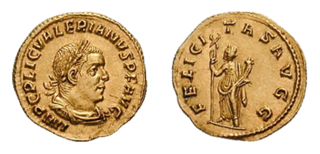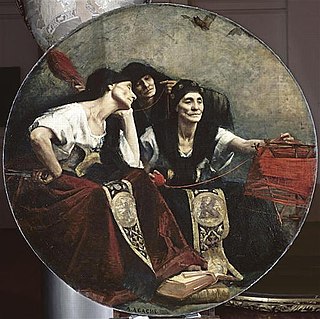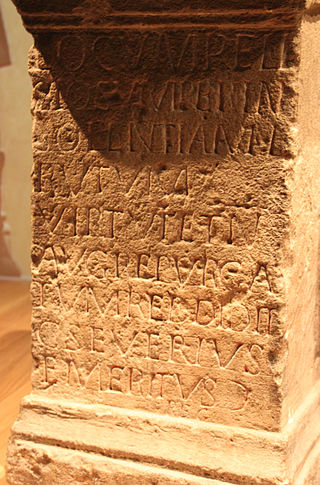
The denarius was the standard Roman silver coin from its introduction in the Second Punic War c. 211 BC to the reign of Gordian III, when it was gradually replaced by the antoninianus. It continued to be minted in very small quantities, likely for ceremonial purposes, until and through the Tetrarchy (293–313).
AD 41 (XLI) was a common year starting on Sunday of the Julian calendar. At the time, it was known as the Year of the Consulship of C. Caesar Augustus Germanicus and Cn. Sentius Saturninus. The denomination AD 41 for this year has been used since the early medieval period, when the Anno Domini calendar era became the prevalent method in Europe for naming years.

The Roman triumph was a civil ceremony and religious rite of ancient Rome, held to publicly celebrate and sanctify the success of a military commander who had led Roman forces to victory in the service of the state or, in some historical traditions, one who had successfully completed a foreign war.

In Roman mythology and ancient religion, Clementia is the goddess of clemency, leniency, mercy, forgiveness, penance, redemption, absolution, acquittal and salvation.

In ancient Roman culture, felicitas is a condition of divinely inspired productivity, blessedness, or happiness. Felicitas could encompass both a woman's fertility and a general's luck or good fortune. The divine personification of Felicitas was cultivated as a goddess. Although felicitas may be translated as "good luck," and the goddess Felicitas shares some characteristics and attributes with Fortuna, the two were distinguished in Roman religion. Fortuna was unpredictable and her effects could be negative, as the existence of an altar to Mala Fortuna acknowledges. Felicitas, however, always had a positive significance. She appears with several epithets that focus on aspects of her divine power.

The mos maiorum is the unwritten code from which the ancient Romans derived their social norms. It is the core concept of Roman traditionalism, distinguished from but in dynamic complement to written law. The mos maiorum was collectively the time-honoured principles, behavioural models, and social practices that affected private, political, and military life in ancient Rome.
Jerzy Sever Linderski is a contemporary Polish scholar of ancient history and Roman religion and law.
A catapulta was a Roman machine for throwing arrows and javelins, 12 feet (3.7 m) or 15 feet (4.6 m) long, at the enemy. The name comes from the Greek katapeltes (καταπέλτης), because it could pierce or 'go through' (kata) shields (peltas). The design was probably inherited, along with the ballista, from Greek armies. Some versions of the catapulta were portable. Smaller two-armed versions of the catapulta were known as scorpiones. The catapulta was made of wood and were placed on stands.

In Roman mythology, Morta was the goddess of death. She was believed to preside over infants who died.

The Montefortino helmet was a type of Celtic, and later Roman, military helmet used from around 300 BC through the 1st century AD with continuing modifications. This helmet type is named after the region of Montefortino in Italy, where a Montefortino helmet was first uncovered in a Celtic burial. The Montefortino helmet originated in the 4th century BCE and was influenced by Etruscan and Celtic helmets. The helmet was brought to Italy by the Senones and it was the most popular helmet amongst the Roman army during the Republican period. The Montefortino helmet remained the most popular Roman helmet until the first century CE. Although in the Roman military it was replaced by the Coolus helmet, it continued to be used by the Praetorian guard.
In ancient Roman religion, Fornax was the divine personification of the oven (fornāx), the patroness of bakers, and a goddess of baking. She ensured that the heat of ovens did not get hot enough to burn the corn or bread. People would pray to Fornax for help whilst baking. Her festival, the Fornacalia, was celebrated on February 17 among the thirty curiae, the most ancient divisions of the city made by Romulus from the original three tribes of Rome. The Fornacalia was the second of two festivals involving the curiae, the other being the Fordicidia on April 19. The goddess was probably conceived of to explain the festival, which was instituted for toasting the spelt used to bake sacrificial cakes. Her role was eventually merged with the goddess Vesta.

Quintus Caecilius Metellus Pius Scipio, often referred to as Metellus Scipio, was a Roman senator and military commander. During the civil war between Julius Caesar and the senatorial faction led by Pompey, he was a staunch supporter of the latter. He led troops against Caesar's forces, mainly in the battles of Pharsalus and Thapsus, where he was defeated. He later committed suicide. Ronald Syme called him "the last Scipio of any consequence in Roman history."

Megullia, surnamed Dotata, was an ancient Roman noblewoman.

Decima was one of the three Parcae in Roman mythology. The Parcae goddess Nona was responsible for pregnancy; Decima was responsible for birth; and Morta was charged with overseeing death. They distributed to mankind all the good and bad things in life, and according to some classical writings even Jupiter had to bend to their will. Decima measured the thread of life with her rod, like her Greek equivalent Lachesis. In some accounts, her mother was Nox the goddess of night and her father was Erebus the god of darkness; while in other accounts, her parents were Jupiter and Themis.

In the constitution of ancient Rome, the lex curiata de imperio was the law confirming the rights of higher magistrates to hold power, or imperium. In theory, it was passed by the comitia curiata, which was also the source for leges curiatae pertaining to Roman adoption.

The vocabulary of ancient Roman religion was highly specialized. Its study affords important information about the religion, traditions and beliefs of the ancient Romans. This legacy is conspicuous in European cultural history in its influence on later juridical and religious vocabulary in Europe, particularly of the Christian Church. This glossary provides explanations of concepts as they were expressed in Latin pertaining to religious practices and beliefs, with links to articles on major topics such as priesthoods, forms of divination, and rituals.

Roman mythology is the body of myths of ancient Rome as represented in the literature and visual arts of the Romans. One of a wide variety of genres of Roman folklore, Roman mythology may also refer to the modern study of these representations, and to the subject matter as represented in the literature and art of other cultures in any period. Roman mythology draws from the mythology of the Italic peoples and ultimately from Proto-Indo-European mythology.

The Latin term religiō, the origin of the modern lexeme religion, is of ultimately obscure etymology. It is recorded beginning in the 1st century BC, i.e. in Classical Latin at the end of the Roman Republic, notably by Cicero, in the sense of "scrupulous or strict observance of the traditional cultus". In classic antiquity, it meant conscientiousness, sense of right, moral obligation, or duty towards anything and was used mostly in secular or mundane contexts. In religious contexts, it also meant the feelings of "awe and anxiety" caused by gods and spirits that would help Romans "live successfully".

In Roman mythology, Dies was the personification of day. She was the daughter of Chaos and Caligo (Mist), and the counterpart of the Greek goddess Hemera.
















